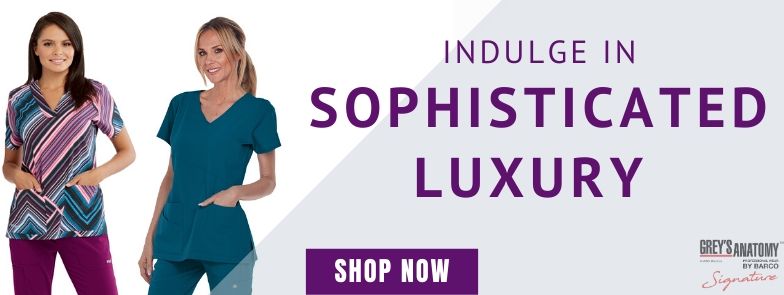8 Reasons Scrubs Are Necessary in the Medical Field
Today, most professionals in the medical field are wearing scrubs. From doctors and nurses, to dentists, pathologists, and vets – scrubs are common attire for most professionals, but why?
Long before scrubs, nurses largely wore white uniforms, while surgeons rarely wore any protective equipment, save for aprons. Supplies and equipment were often non-sterile and reused and handled bare-handed.
It was only sometime after the Spanish influenza that surgeons began using gloves, and by the 1940s, a wave of antiseptic practices and advancements made throughout the late 19th and early 20th century led to disposable and sterile equipment, antiseptic gowns, and white operating room attire.
It was several decades after, around the 60s and 70s, that surgeons (and by extension, nurses and doctors) began wearing scrubs – largely green and/or blue, a sudden departure from the traditional white color due to massive laundry pains and literal headaches (caused by eye strain). So, why do professionals in the medical field wear scrubs today?
The Importance of Scrubs in the Medical Field
This equipment eventually became known as a pair of scrubs, because it’s used in a sterile (scrubbed) environment. Since then, we’ve come a far way in preventing cross contamination and infection by way of better sanitary practices and strict biohazard rules.
But beyond developing as a way to better protect against blood and guts, there are many reasons scrub outfits are necessary in the medical field – for nurses, surgeons, and doctors of all kinds alike.
1. Scrubs Reduce Eye Strain
When surgeons first made the switch to colors other than white, blue and green were chosen first and foremost because of their natural contrast to red, making it easier to wash out or ignore certain stains, and providing far less anxiety to patients seeing others covered in blood.
Furthermore, because surgeries can last over a dozen hours, the constant red focal point of a patient’s viscera often led to eye strain and headaches, especially when the only other thing to look at was a colleague’s white and blood-spattered operating room attire. Green and blue were natural colors to help the eyes take a break and readjust after hours spent staring at various reds.
2. Scrubs are Easy to Wash
When it became abundantly clear that doctors and surgeons would be remiss to simply wear their own clothing when treating patients, it became necessary to develop attire that could be easily worn, washed, and reused, drying quickly and taking little time to prepare.
Scrubs are as simple as clothing can get, consisting of a single top with no collar, buttons, or long sleeves, and a pair of pants pulled tight with a drawstring. Furthermore, their color allows bloodstains and other bodily fluids (such as urine and amniotic fluid) to be less obvious, especially after several washes, while white stains very easily.
3. Scrubs are Breathable and Flexible
Scrubs are typically made with a combination of cotton, spandex, and polyester. This allows the resulting fabric to be breathable yet flexible, comfortable on the skin without being thick or heavy, and very stretchable without being too fitting or skintight.
Different companies use different blends, but all scrubs are generally designed to allow the skin to breathe and maximize mobility. Special fabrics are designed for some scrubs, with moisture-wicking properties to remove the wearer’s sweat, and special antimicrobial fibers.
4. Scrubs Separate Staff from Patient
Doctors, nurses, assistants, technicians, and even janitorial staff will wear scrubs, lab coats, and scrub-like clothing in hospitals and clinics, making it much easier for patients to know who to address as a member of the staff, and who might be a fellow patient or visitor.

5. Scrubs are Affordable
Made from an affordable blend of fabrics and cut with minimal excess and pure ergonomics in mind, scrubs are both practical and economical. This is especially important for hospitals that purchase disposable scrubs.
However, if these are an ecological concern, higher-quality scrubs with longevity in mind also exist, but need to be washed thoroughly and regularly, sometimes with quite harsh chemicals.
6. Scrubs Help Protect Medical Professionals
While their efficacy is challenged by some, scrubs are often infused with antimicrobial fibers made to combat the potential of direct contamination when meeting a sick patient.
Hospitals are, quite sensibly, a hotbed of bacteria and viruses, and doctors and nurses are at great risk of not only infecting different patients, but themselves as well. Strict sanitary rules and frequent handwashing are critical to help avoid this to a degree, but antimicrobial clothing may play a role in preventing infection as well.
7. Scrubs are Made for Medical Use
Designed with simplicity and ergonomics in mind, scrubs also usually sport several pockets for a penlight, surgical scissors, stethoscope, ophthalmoscope, and much more.
Doctors and nurses alike will often require a whole kit of different tools and pens in order to fulfill basic tasks, from making notes on hospital charts to checking for a concussion.
8. Scrubs Minimize Cross Contamination
By wearing normal clothes at home and out about in public, and wearing special scrubs for operating rooms, and different scrubs for interactions with patients in and outside of the office, doctors, nurses, and other hospital professionals ensure that they keep potential cross contamination to a minimum, than if they were wearing the same scrubs and clothes throughout multiple activities.
Doctors that would stay in their hospital clothes while out shopping for groceries would endanger others by spreading a host of potential bacteria, and likewise, it’s critical to ensure that all civilian clothes are covered completely by one’s scrubs.
Healthcare-acquired infections continue to be a serious issue in many hospitals across the country, but scrubs are one of the ways in which this major health hazard has become more manageable over the decades.
Conclusion
Beyond just looking good and comfortable, there are plenty of practical reasons for the widespread adaptation of the scrubs in the medical field. For decades, they’ve become a staple in:
- Doctor’s offices
- Operating rooms
- Clinics
- Triage tents
- Veterinary offices, and more
However, even among scrubs, there are differing degrees of quality. Some are designed specifically to last a certain number of washes before being disposed – these are usually wholesale purchased and employed by hospitals, issuing their own scrubs to staff to use and launder in-house. There are also scrubs designed to offer greater comfort and functionality, with a wide variety of sizes, fits, and cuts to cater to all body types and individuals.



